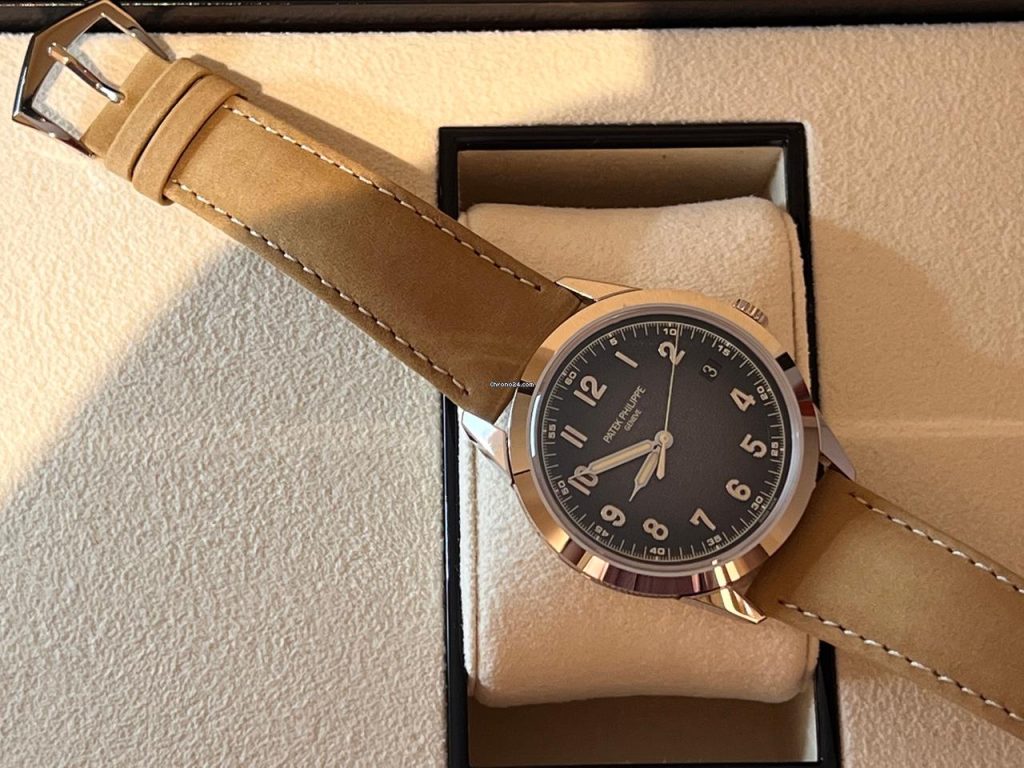Tracing the Movement: Is the CALATRAVA 5226G Powered by a Modified ETA?
When Patek Philippe released the Calatrava 5226G, many collectors initially saw it as a subtle nod to new design ambitions: a textured charcoal dial with cream-lumed Arabic numerals, syringe-style hands, and a stepped case that felt decidedly more “neo-vintage” than anything previously in the Calatrava family. At $39,000 USD, it was positioned as an entry into the world of Patek ownership—modern, minimal, and versatile. But keen-eyed horologists began asking uncomfortable questions once technical specifications started surfacing. Beneath the gold case and finely finished dial, was Patek quietly using a decades-old movement core?
At the heart of the 5226G is the caliber 26-330 S C. Officially, it’s an in-house automatic movement with central seconds and date. But dig deeper into its lineage and the whispers grow louder: the architecture of the 26-330 S C bears striking resemblance to the long-serving ETA 2892-A2—a movement introduced in the early 1990s and widely used by brands such as Omega, Tudor, and even Hamilton in earlier generations. Some components—plate layout, wheel spacing, and rotor geometry—are so similar that watchmakers have found they can interchange parts with only slight adjustments.
How is this possible for a brand like Patek, which built its reputation on vertical integration and artisanal excellence? The answer lies in what horology insiders call a “re-engineered platform.” Instead of designing every caliber from scratch, some manufacturers take proven third-party architectures and refine them to the point of near-total transformation—upgrading materials, improving tolerances, and applying meticulous finishing. By the time these movements reach the consumer, they’re often functionally indistinguishable from true in-house calibers—at least in performance. But not necessarily in originality.
In the case of the 26-330 S C, multiple teardown reports—including one from an independent Geneva-based service technician—point to ETA-derived underpinnings. The center wheel bridge and winding mechanism show signs of ETA’s original engineering, while the escapement geometry suggests modifications rather than a clean-sheet redesign. Patek defenders argue that the final product is built in-house to much tighter tolerances, with silicon components and a Gyromax balance wheel. That may be true. But for purists who expect a movement designed entirely from scratch by Patek’s advanced research lab, the revelation is more than a little disillusioning.
Why Is the Market Still Paying Triple MSRP? The Psychology Behind It
Despite this technical lineage, the Calatrava 5226G continues to trade at up to 300% above retail on the secondary market. How can a watch accused of housing a glorified ETA core command such intense demand?
The first factor is brand perception. Patek Philippe has cultivated one of the strongest reputations in luxury goods—beyond watches. It represents a worldview, a family legacy, a collector’s rite of passage. Whether a Calatrava holds a modified ETA or an ultra-complex minute repeater is, to some buyers, irrelevant compared to the status conferred by the Calatrava name and the signature Geneva Seal.
Second, the 5226G’s design speaks to a generational shift. Younger collectors—especially those entering the luxury market post-COVID—want “stealth wealth” pieces: watches that look modern but don’t shout their price tags. The textured dial, versatile case size, and tool-watch aesthetic of the 5226G check all the boxes. Its vintage military undertones, combined with dress watch proportions, create a hybrid that appeals to both traditionalists and neo-luxury seekers.

Third, scarcity still fuels demand. Patek deliberately controls production volume, and the Calatrava line—long considered secondary to Nautilus or Grand Complications—receives fewer units per retailer. This creates friction in supply just as demand is heating up among a new class of enthusiasts.
Finally, there’s a deeper psychological mechanism at work: the Endowment Effect. When buyers acquire something with a high perceived brand value, they begin rationalizing flaws. Instead of questioning the movement’s origin, owners double down on the narrative that the 5226G is “the ultimate daily Patek” or “a connoisseur’s sleeper pick.” Emotional attachment clouds technical scrutiny.
Affordable Alternatives: Five Watches That Share the Movement DNA for 90% Less
If the 26-330 S C truly shares a foundational structure with the ETA 2892-A2, then there are far more affordable watches offering comparable reliability—minus the prestige markup. Here are five such references, all featuring the ETA 2892-A2 or closely derived equivalents, at a fraction of the price.
- Longines Master Collection L2.673.4.78.3
Powered by the L687—a modified 2892-A2 with a column-wheel chronograph module—this piece offers multi-functionality in a traditional dress case for under $3,000. While not finished to Patek’s standards, it represents immense value. - Sinn 6068 Frankfurt Financial District
Built with a Top-Grade ETA 2892-A2, this German classic merges dual-time functionality with understated business styling. Anti-magnetic, water-resistant, and ruggedly elegant, all for around $2,500. - Omega Seamaster 300M Pre-Co-Axial (early 2000s)
Before the in-house revolution, Omega used chronometer-grade ETA 2892 variants in their flagship dive watches. These older Seamasters remain exceptional daily wearers, often available on the secondary market for $1,800–$2,200. - Ebel 1911 BTR Chronograph
A sleeper hit among enthusiasts, the Ebel 1911 BTR line used heavily modified 2892 movements to create modular chronographs with beautiful finishing. Resale values hover around $2,000–$3,000. - Glycine Combat 6 Classic Automatic
Minimalist, well-built, and powered by a standard 2892, the Glycine Combat 6 is a pure expression of mid-century style and mechanical simplicity—for under $1,000.
Of course, none of these watches carry the aura or finishing of a Patek. But for collectors focused purely on movement function, reliability, and horological transparency, they offer clean alternatives with decades of serviceability behind them.
The Bigger Picture: What Does ‘In-House’ Really Mean in 2025?
The Calatrava 5226G case reveals more than just a questionable movement choice—it signals the growing ambiguity around the term “in-house.” Once a badge of independence, “in-house” now includes modular platforms, third-party architecture with bespoke components, and even full external production under internal supervision. In this evolving landscape, transparency matters more than terminology.
Watch enthusiasts are growing more educated. With teardown content, movement comparison videos, and open-source horology databases proliferating online, brands can no longer rely on surface gloss. The future of luxury watchmaking may not lie in secrecy—but in storytelling. A reworked ETA movement isn’t necessarily inferior—it just needs to be contextualized honestly.
Patek Philippe, by continuing to push vintage-inspired aesthetics and pricing newer models as “accessible,” must now confront a generation that asks sharper questions. Legacy alone won’t carry future sales. If the 5226G is to remain a collector’s darling, it will need more than prestige—it will need performance that speaks as loudly as the name on the dial.





































